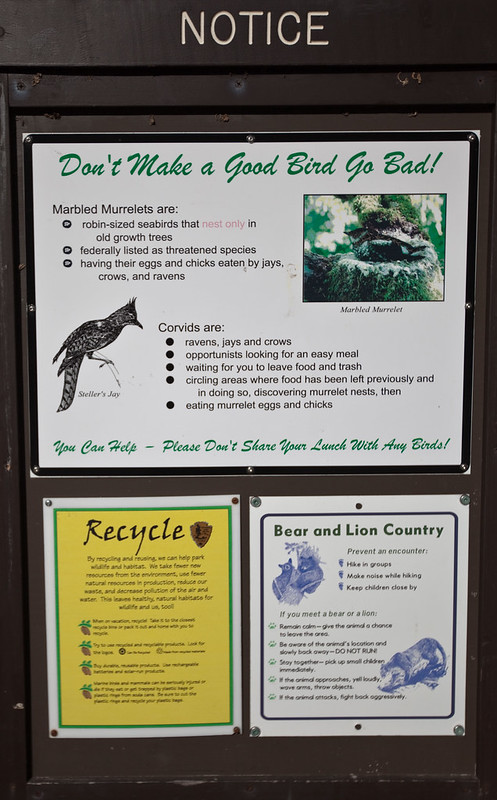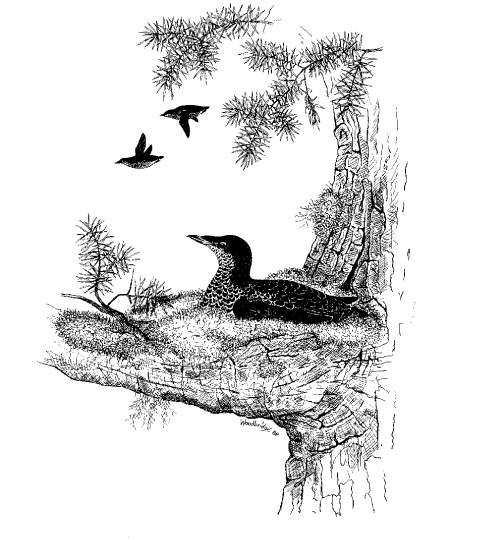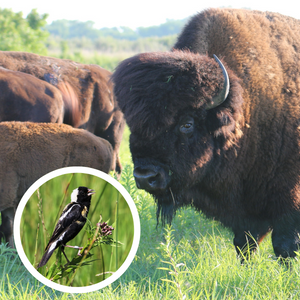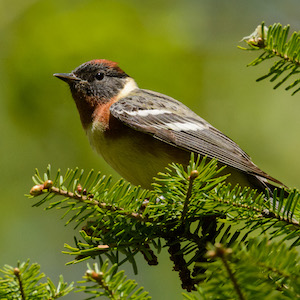As bird lovers, we’ve all been tempted by the charismatic corvid and many of us have given in to their charms. Here’s how they work their magic. You sit at the campground picnic table munching your trail mix and discussing your hiking plans when a Steller’s Jay drops from a nearby tree and lands at the end of the table. He jauntily cocks his crested head, twinkles his eyes at you and hops a bit closer. “Could I have one of those peanuts?” he asks with his body language. The campground sign says “Don’t feed the birds!” and you know you shouldn’t, but you think “He’s so gorgeous and look how he’s looking at me! Surely one peanut won’t hurt…” Little do you know, he’s already run this con at two other campsites this afternoon and feasted on a dozen tortilla chip bits spilled by the kids one site over.

A park sign entitled "Don't Make A Good Bird Go Bad!" Photo by Chris D 2006/Flickr.
How do all those peanuts and chips affect the jay’s foraging behavior and the local jay population? And how do those jays affect the populations of other species in the area. In a paper published yesterday in Ecosphere, Elena West of the University of Minnesota and IBP’s Southwest Avian Ecologist, Harry Jones, examine how human food subsidies (peanuts, chips, etc.) affect Steller’s Jays in Big Basin Redwoods State Park in California and the implications for the threatened Marbled Murrelets that also nest there. These small, imperiled seabirds nest on the branches of redwoods in the park and Steller’s Jays, being omnivores, will happily eat their eggs.
West and Jones observed the foraging behavior of radio-tagged jays, but also got insight into their diets using their feathers. They used stable isotope analysis of feather samples to determine how much human food the jays were eating. Isotopes are versions of the same element (e.g. carbon or nitrogen) that have different numbers of neutrons in their nucleus. Jones explains how isotopes can tell you about a bird’s diet:
“Different plants uptake the 'heavier' isotopes at different rates, and corn in particular tends to have a higher proportion of the heavy carbon isotope. Human foods, which frequently contain corn or corn syrup, have different proportions of heavy isotopes from natural foods. When we eat foods, the different isotope proportions get added into our tissues (we are literally what we eat!), so the relative proportions of carbon isotopes in a feather can tell you what a bird was eating when it grew it out (the same is true for human hair or fingernails, for example.)”
The researchers found that individual jays in the park specialized on different types of food. Some specialized on human food and tended to forage closer to the ground, while other jays foraged higher in the forest canopy and specialized on wild foods. “I was really surprised that even in campgrounds, where high calorie human food is everywhere, some jays still specialize on other food sources, like insects, berries, and acorns,” says Jones. “You would never guess that without following radio-tagged birds, because 99% of the birds you see in the campgrounds are on the ground near campers.” Because these two foraging strategies don’t overlap much, it reduces competition for food and allows for a larger population of jays in the area.
Now a devil’s advocate type might ask “Why does it matter to the murrelets if there are more jays around? The extra jays are just eating human food.” Unfortunately, it’s not that simple because Steller’s Jays are both omnivores and opportunists. Jones explains:
“Jays don't specialize on murrelet eggs as a food source, they are much too rarely found. Instead, they tend to eat murrelet and other species' eggs opportunistically, usually while they are out hunting for something else. So having so many more jays in the campground means that the odds of one finding a murrelet nest are much higher just by blind luck. Reducing jay (and raven) densities to 'natural' levels in the remaining old-growth redwood stands where murrelets nest is one key to protecting the central California murrelet population.”

A Marbled Murrelet on its nest on a tree limb. Illustration by Brian Woodbridge.
How do we reduce jay numbers? Stop feeding them and secure trash so that we are not feeding them inadvertently. Corvids, like Steller’s Jays, have co-existed with murrelets for thousands of years, but humans are throwing their relationship out of balance. After this study was completed the campgrounds and visitor center at Big Basin Redwoods State Park burned in the 2020 CZU Lightning Complex fire. Thankfully most of the redwoods survived and this tragedy gave the state park, which is California’s oldest, an opportunity to rethink where to put their human infrastructure. They are planning to rebuild the campgrounds outside of the old growth forest where the murrelets nest.
If we want to enjoy species like Marbled Murrelets and Steller’s Jays for centuries to come, we need to think more deeply about how our actions–even well-meaning ones–affect the wildlife we love. “I think this work highlights a little of the huge influence that human beings can have on animal communities, even on protected lands,” says Jones. “Our actions like feeding wildlife can have huge repercussions that we are unlikely to notice during a weekend camping trip, but which can have a major influence on wildlife populations and endangered species. This is one example of why feeding wildlife in state and national parks is always a bad idea.”






